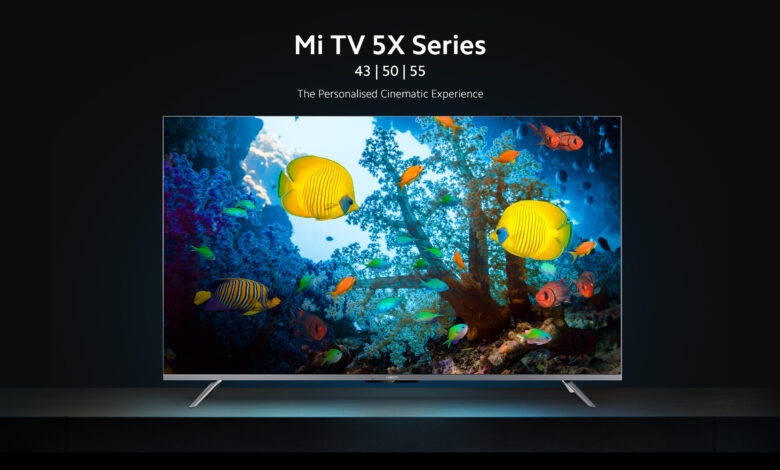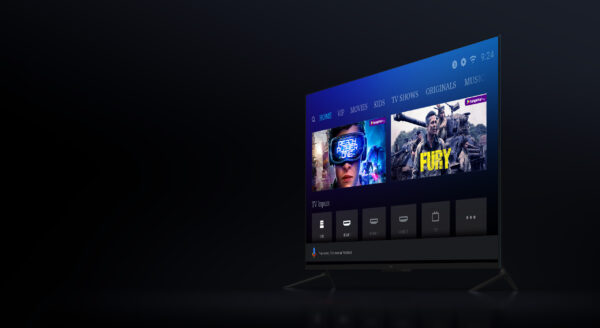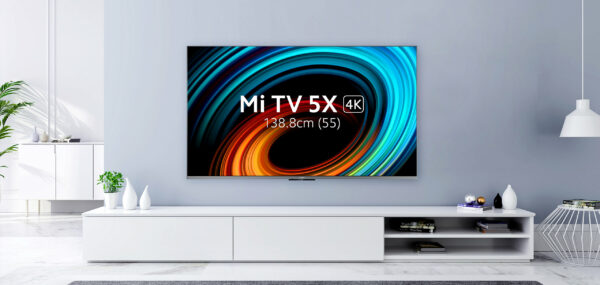
Xiaomi’s TVs appear to be one of the safer alternatives for anyone with a budget of less than $50,000. The TV has a small and elegant design, 4K Dolby Vision display, 40W Dolby Atmos speakers, Android TV software with the proprietary Patchwall UI, and three HDMI 2.1 connectors, among other features. Now, while the on-paper spec list looks promising, we’ll have to wait and see how everything works in practice and if any corners are made that you should be aware of.
Read our overview of the 55-inch Xiaomi Mi TV 5X.
Due to the weight and size of the package, you’ll need another pair of hands to assist you in unpacking it. Styrofoam frames surround the television. It’s simple to remove the television and place it on a table. Here’s what you’ll find inside the box:
The computer monitor (with non-detachable power cord)
- (2) Screwed Table Top Stands (4) Remote (Batteries not included)
- Instructions for Use and Installation
The display
If you want to mount the Xiaomi Mi TV 5X on a wall, you’ll need to buy the necessary accessories separately. The chassis is built of high-quality plastic and also has a formal appearance. The TV was seated on a table, and the inverted V supports did a great job of keeping it in place. The object would only budge if you jolted it.
Nevertheless, you can see how sleek and slender its body is from the side. The entire fascia also appears attractive because the bezels are narrow on all sides (save the chin) and are metallic grey in tone. A vivid Xiaomi logo can be found on the bottom bezel.
A button on the remote may also be used to control Google. And when it comes to this small plastic cuboid, it only has a minimal amount of keys. A startup key, the previously stated assistant trigger, a navigating ring, a Patchwall, an Android TV home key, Netflix, Amazon Prime, volume rockers, and Mi branding are all there.
At first, the lack of a mute button, a YouTube hotkey, and maybe even an input source key would be discouraging. However, there are a few shortcuts, such as double-tapping the volume down to mute or long-pressing the Mi button to access fast settings such as Picture, Sound, Input, and TV Lock. This approach has a minor flaw, which we shall discuss in more detail in a later section.A giant glossy Xiaomi logo borders the ports on the right and the charging wire on the left on the rear. The latter isn’t removable, which is a little disappointing.

The Audiovisual of Xiaomi Mi TV 5X
The Vivid Picture Engine 2 is used in this 55-inch IPS LCD panel, with a 10-bit color depth and a 94 percent DCI-P3 color gamut. It has a 4K resolution and supports Dolby Vision, HDR10, and HDR10+ HDR standards. The slim bezels result in a 96.6 percent screen-to-body ratio. The 178° viewing angles were charming.
It is bright enough for everyday usage and has an adjustable brightness option in the settings. Backlighting is provided via direct LEDs. Both SDR and HDR content on it satisfy to naked eye.
On this screen, web shows like Squid Games (2021, Netflix) and Kota Factory S02 (2021, Netflix) looked fantastic. The chase moments in Mad Max Fury Road (2015, Prime Video) and the gloomy passages in Jack Ryan S02 (2018, Prime Video) were noticeable. Because of the iconic soap-opera effect, When elected to keep Motion Smoothning on when watching Ready Player One (2018, Prime Video).
Now, I’m not a big lover of movie mode; instead, I’ll utilize it when it feels appropriate for the stuff I’m watching. Yes, you may use the ‘long-press the Mi button’ shortcut to swap between the various picture settings such as Standard, Movie, Sports, and Vivid.
Sticking to the script, this panel offers a 60Hz refresh rate and supports 4K60 resolution. You can connect your PC or console and play on the large screen thanks to the availability of three HDMI 2.1 ports. If you’re not comfortable, you can get by with some code and surfing.
ALLM (Auto Low Latency Mode) and eARC are two more HDMI 2.1 features to consider (Enhanced Audio Return Channel). The latter, which is only accessible on the second HDMI 2.1 connector, allows you to use the Mi TV 5X remote to control audio from the TV and the soundbar. Convenient! By switching to Game Mode, the former favor frames above visuals.
The sound from the 40W speakers is as unique as you’d expect, thanks to Dolby Atmos and DTS HD. When listening to music on Spotify or similar services, the level might go relatively high. However, the bass was not that deep. Dialogue Enhancer may be enabled if you go far enough into the sound settings.

The User interface
Xiaomi has included its Patchwall UI as an extra launcher for Android TV version 10. It has a more attractive design and consists of a better-organized content library, universal search, kids mode with Parental Lock, 75+ live channels, Mi Home (IoT control), and more. The latter may be configured as the default home screen. If you have subscriptions on several OTT platforms, it will compile lists and give intelligent suggestions based on language, release date, cast, and other factors. Nifty! Otherwise, it appears that uninvited apps and advertisements are fighting for your attention.
All of this is driven by a quad-core A55 CPU, which is paired with a Mali G52 MP22 GPU, 2GB of RAM, and 16GB of storage.
The connectivity
The port selection is acceptable even in terms of connection. There are three HDMI 2.1 connections on the Xiaomi MI TV 5X, one of which supports years. 2x USB A (2.0), 1x LAN, 1x AV, 1x Optical x 1, 1x Antenna Tuner, and 1x 3.5mm audio jack round out the features. Xiaomi does not include an AV composite cable with the device.
Dual-band WiFi ac, Infrared, and Bluetooth 5.0 are the wireless choices. The latter allows you to manage television from a distance and even from an off-angle.
Final Judgement
Xiaomi excels at what it does. That is, to provide a competitive product at a reasonable cost. This new 4K Xiaomi Mi TV from 2021 appears to be upgraded with improved specifications and capabilities. This offers 4K HDR graphics powered by Vivid Picture Engine 2, HDMI 2.1 connections (with 4K60 output, ALLM, and eARC), a potent 40W speaker configuration, Patchwall software delights, and more all packaged in a thin, robust, and stylish design.
Thus, if you’re searching for a new 4K smart TV for less than Rs. 50,000, this is a good option. Xiaomi has a more robust brand cache and a more comprehensive customer care network than its competitors.
If you want to save even more money, keep in mind that the other two Xiaomi Mi TV 5X models will set you back at just $31,999 and $41,999, respectively. You may find them on mi.com, Flipkart, Xiaomi Mi Home, Xiaomi Mi Studio, and Croma, among other places.

Reasons to purchase
- Design is slim and appealing.
- Display in 4K HDR
- Speakers with a lot of volumes
- HDMI 2.1 (ALLM, eARC) and a good connection suite are included.
- Patchwall is a handy tool.
- Google Assistant with no need to use your hands
Reasons to avoid purchasing
- It isn’t easy to hear the conversation in some videos, and switching between fast settings isn’t always smooth.
- There is no wall mount supplied.
EDITED AND PROOFREAD BY NIKITA




